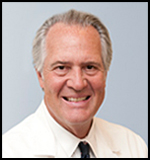Massachusetts General Hospital

Harry E. Rubash, M.D.
Edith M. Ashley Professor of Orthopaedic Surgery
Harvard Medical School
2011-12 Chief's Report
Laboratory of Musculoskeletal Engineering
The Laboratory for Musculoskeletal Tissue Engineering, under the direction of Mr. Mark Randolph and Dr. Thomas Gill IV, focuses on cartilage repair and regeneration in the knee. Together they have a research program exploring tissue engineering approaches to repair and regenerate traumatic sports-related injuries, particularly to the shoulder and knee. The mission of the Laboratory for Musculoskeletal Tissue Engineering is to conduct cutting-edge research in tissue engineering and regenerative medicine for repairing and regenerating musculoskeletal tissues to restore normal function to patients. The Laboratory provides training in research methodology to undergraduates, medical students, and postdoctoral research fellows. Programs have been developed in three primary areas: 1) articular cartilage repair and regeneration; 2) meniscal repair and replacement; and, 3) photochemical tissue bonding to promote healing.
One area of investigation is to develop novel hydrogel polymers for delivering chondrocytes or chondrogenic precursor cells to cartilage defects. Using this approach, cells can be incorporated into the liquid phase of the polymers, injected into a defect area, and the gel polymerized in situ. The expected outcome is that new cartilage matrix is formed as the polymer biodegrades. In-vivo results have been published using fibrin polymer, poly (ethylene glycol), and hyaluronic acid gels. A primary goal of the hydrogel studies is to translate this basic research to clinical application. A recent study by a group funded by the NFL Charities focused on the properties of cartilage engineered from elderly human chondrocytes in comparison to swine chondrocytes (Tissue Eng Part A. 2012 Jul;18(13-14):1490-9). Ongoing work sponsored by the US Department of Defense is focused on developing photochemically crosslinked hydrogels for cartilage repair and regeneration in a preclinical large animal swine model. Previous studies have demonstrated that PEG (Tissue Eng Part A. 2011 Jan;17(1-2):161-9) and collagen (J Knee Surg 2009 22(1):72-81) hydrogels can be photochemically crosslinked to encapsulate chondrocytes to facilitate new cartilage matrix formation in nude mice. This project aims to move this technology toward clinical application. In collaboration with Dr. Robert Redmond from the MGH Wellman Center for Photomedicine, and Dr. Kristi Anseth, a chemical engineer at the University of Colorado, the group is expanding their studies on photochemically crosslinked gels such as collagen and norbornene gels. With greater understanding of cell polymer interactions, and the possible incorporation of growth factors, it may be possible to engineer cartilage that resembles native cartilage in every parameter. Other approaches are also being tested with nondegradable hydrogels. In collaboration with Orhun Muratoglu, PhD and the HOL, the group is exploring a hybrid scaffold composed of non-degradable poly (vinyl alcohol) scaffolds combined with chondrocytes for joint cartilage replacement. Several types of PVA hydrogels have been tested for cell compatibility and cartilage formation in mice with support through an Academic Enrichment Fund (AEF) grant from the Department of Orthopedic Surgery. To date, several candidate gels have been identified that support new cartilage formation. One recent publication describes the use of this PVA gel for craniofacial purposes (Bichara DA, et al, J Surg Res. 2010, Apr 24).
In addition to lesions in the articular joint cartilage, lesions to the meniscus can lead to significant morbidity in the knee. In cases where the meniscus is removed, or even partially removed, the biomechanical function of the knee can be severely disrupted resulting in articular cartilage degeneration and osteoarthritis. Some lesions can be stabilized to promote healing, particularly in the outer vascularized regions. However, lesions in the inner avascular regions do not heal, even with anchors and sutures. Previous work funded by the AO Foundation focused on tissue engineering strategies to repair lesions in the avascular regions of the meniscus. The results demonstrated an efficient means to seed chondrocytes onto polygalactin (PLGA) scaffolds, and the capacity of this cell-scaffold constructs to heal bucket handle lesions made in swine menisci. Recent work funded by the Musculoskeletal Transplant Foundation has allowed us to improve the seeding of scaffolds (J Biomed Mater Res A. 2011 Oct; 99(1):102-8) and test the utility of allogeneic chondrocytes for healing lesions in the swine meniscus. This work is nearing completion and will demonstrate the contribution of the allogeneic cells to the repair, as well as document the host’s immune response to the allogeneic cells. Another strategy is to develop (cell-free) scaffolds that can be used to regenerate the meniscus after partial meniscectomy. One scaffold under study is the use of a dermal bovine collagen scaffold made by TEI Biosciences, which can be used to replace meniscus and regenerate meniscal tissue.
Torn ligaments and tendons often heal with inferior mechanical strength of the native uninjured tissue. Collagen-rich tissues can be bonded using photosensitive dyes and light. Such a strategy may have many applications in promoting healing of tendons and ligaments. One area being actively investigated is the bonding of severed tendons using Rose Bengal dye that is irradiated with green light. Additionally, protein rich materials can be used in the bonding process to augment the strength of the repair. Silk and collagen membranes are candidate materials that are under investigation in combination with photochemical tissue bonding to promote healing of tendons. A recent study to be published in Lasers and Surgery in Medicine (Lasers Surg Med. 2012 Aug 21. doi: 10.1002/lsm.22066.) [Epub ahead of print] describes the use of an electrospun silk construct bonded to transected Achilles tendons in rabbits, which showed a decrease in adhesions and an increase in early tendon mechanical strength.
- MGH Chief's Report
- Introduction
- Bicentennial
- Innovation
- In Memorium
- New Faculty
- HCORP
- Retreat
- Facilities
- Center for MoM THR
- Courses
- Subspecialties
- Adult Reconstructive
- Hand & Upper Extremity
- Foot & Ankle
- Oncology
- Pediatrics
- Podiatry
- Shoulder
- Sports
- Spine
- Trauma
- Research Labs
- Sarcoma & Mol Bio
- MSK Res & Innovation
- MSK Engineering
- Bioengineering
- Shoulder Biomotion
- Harris
